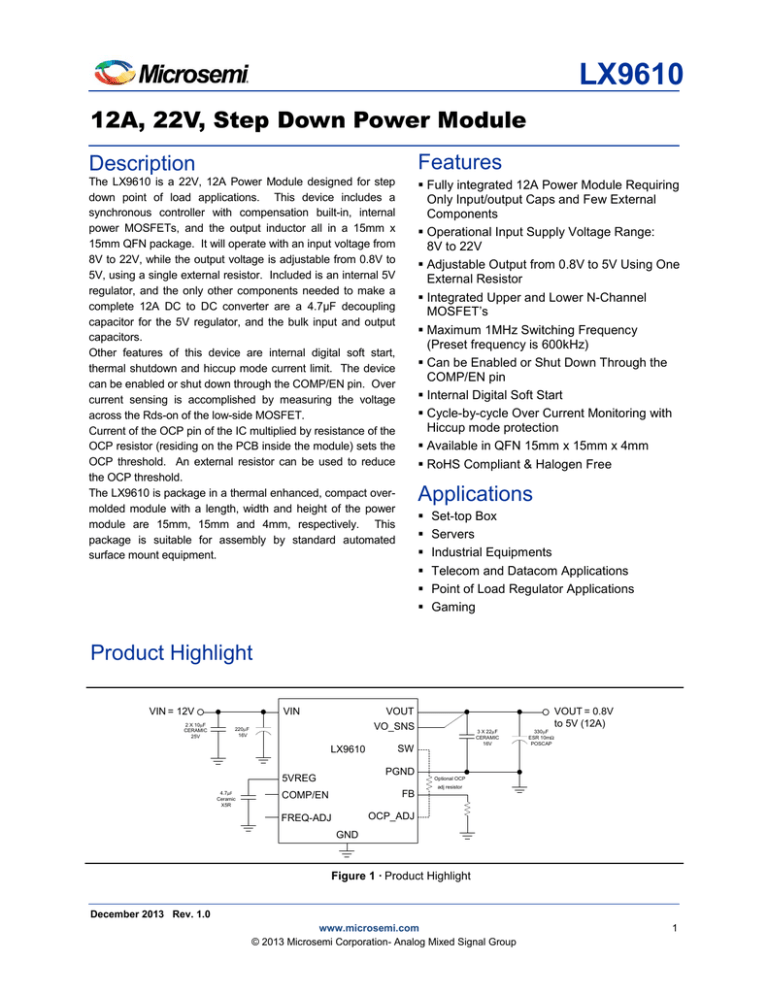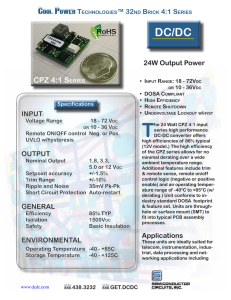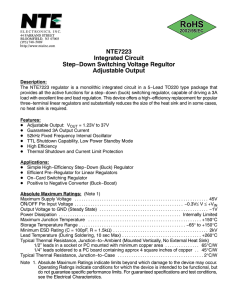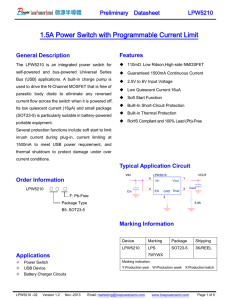
LX9610
12A, 22V, Step Down Power Module
Description
Features
The LX9610 is a 22V, 12A Power Module designed for step
down point of load applications. This device includes a
synchronous controller with compensation built-in, internal
power MOSFETs, and the output inductor all in a 15mm x
15mm QFN package. It will operate with an input voltage from
8V to 22V, while the output voltage is adjustable from 0.8V to
5V, using a single external resistor. Included is an internal 5V
regulator, and the only other components needed to make a
complete 12A DC to DC converter are a 4.7µF decoupling
capacitor for the 5V regulator, and the bulk input and output
capacitors.
Other features of this device are internal digital soft start,
thermal shutdown and hiccup mode current limit. The device
can be enabled or shut down through the COMP/EN pin. Over
current sensing is accomplished by measuring the voltage
across the Rds-on of the low-side MOSFET.
Current of the OCP pin of the IC multiplied by resistance of the
OCP resistor (residing on the PCB inside the module) sets the
OCP threshold. An external resistor can be used to reduce
the OCP threshold.
The LX9610 is package in a thermal enhanced, compact overmolded module with a length, width and height of the power
module are 15mm, 15mm and 4mm, respectively. This
package is suitable for assembly by standard automated
surface mount equipment.
Fully integrated 12A Power Module Requiring
Only Input/output Caps and Few External
Components
Operational Input Supply Voltage Range:
8V to 22V
Adjustable Output from 0.8V to 5V Using One
External Resistor
Integrated Upper and Lower N-Channel
MOSFET’s
Maximum 1MHz Switching Frequency
(Preset frequency is 600kHz)
Can be Enabled or Shut Down Through the
COMP/EN pin
Internal Digital Soft Start
Cycle-by-cycle Over Current Monitoring with
Hiccup mode protection
Available in QFN 15mm x 15mm x 4mm
RoHS Compliant & Halogen Free
Applications
Set-top Box
Servers
Industrial Equipments
Telecom and Datacom Applications
Point of Load Regulator Applications
Gaming
Product Highlight
VIN = 12V
2 X 10µF
CERAMIC
25V
VIN
LX9610
3 X 22µF
CERAMIC
16V
SW
PGND
5VREG
4.7µF
Ceramic
X5R
VOUT = 0.8V
to 5V (12A)
VOUT
VO_SNS
220µF
16V
COMP/EN
FB
FREQ-ADJ
OCP_ADJ
330µF
ESR 10mΩ
POSCAP
Optional OCP
adj resistor
GND
Figure 1 · Product Highlight
December 2013 Rev. 1.0
www.microsemi.com
© 2013 Microsemi Corporation- Analog Mixed Signal Group
1
12A, 22V, Step Down Power Module
Pin Configuration
Figure 2 · Pinout (Top View)
Top mark
MSC
LX9610
YYWWA = Year/Week/Lot Identifier
Ordering Information
Ambient
Temperature
Type
Package
RoHS2 compliant,
-40°C to 85°C
Pb-free
QFN 15 x 15 x 3.75
Matte Sn lead finish
15L
Part Number
Packaging Type
LX9610ILQ
Tube
LX9610ILQ -TR
Tape and Reel
MSL 3
Pin Description
Pin Number
2
Pin Designator
Description
These pins are connected to the GND pin of the controller IC. Connect the
external controller components to these pins for ground connection.
1, 2, 3, 4
GND
5
5VREG
The output of the internal 5V regulator. A 4.7µF ceramic cap must be
connected from this pin to GND.
6
VO_SNS
This pin is connected to the VOUT at the regulation point of the load.
7
Unused
8
OCP_ADJ
9
VIN
NC, this pin is not used.
A resistor between this pin and SW pin adjusts the OCP threshold down.
Power input pin of the module. Connect a low ESR bulk capacitor from this pin
to GND to have low ripple voltage at this pin.
Absolute Maximum Ratings
Pin Number
Pin Designator
Description
Switch node pin. The high-side and low-side MOSFET’s and the inductor are
connected to this pin. If needed, connect an R-C snubber network from this pin
to GND to limit the voltage spike at this to 30V (max).
10
SW
11
PGND
Power ground pin. Connect the input and output bulk caps to this pin for
ground connection. This pin needs to be connected to GND pins on the
application PCB.
12
VOUT
Output terminal of the power module. Connect a 330µF POSCAP in parallel
with three 22µF ceramic caps from this pin to PGND pin.
13
COMP/EN
This is the output of the transconductance error amplifier. Pulling this pin to
ground shuts down the power module. Floating this pin enables the power
module.
14
FB
15
FREQ-ADJ
Feedback pin. A resistor connected from this pin to GND sets the output
voltage. Use the formula: VOUT = VFB * (1 + 49.9k / RFB)
Switching frequency adjustment pin. With this pin floating, the module will have
a switching frequency of 600kHz. By connecting an external resistor from this
pin to GND, the switching frequency can be increased. Maximum frequency
allowed is 1MHz.
Absolute Maximum Ratings
Value
Units
Supply Input Voltage (VIN)
-0.3 to 25
V
Switch Node Voltage (SW)
-0.3 to 30
V
Parameter
All Other Pins
-0.3 to 6.5
V
Operational Ambient Temperature
-55 to +125
°C
Storage Temperature Range
-65 to +150
°C
245
°C
Peak Package Solder Reflow Temperature (40 seconds
maximum exposure)
Exceeding these ratings could cause damage to the device. All voltages are with respect to GND.
Currents are positive into, negative out of specified terminal. These are stress ratings only and
functional operation of the device at these or any other conditions beyond those indicated under
“Recommended Operating Conditions” are not implied. Exposure to “Absolute Maximum Ratings” for
extended periods may affect device reliability.
Thermal Properties
Thermal Resistance
Typ
θJP Junction to Pads
1.5
θJA Junction to Ambient
8
Units
°C/W
Note: Note: The Jx numbers assume no forced airflow. Junction Temperature is calculated using
TJ = TA + (PD x JA). In particular, θJA is a function of the PCB construction. The stated
number above is for a four-layer board in accordance with JESD-51 (JEDEC) with thermal
vias on VIN, SW, VOUT, and PGND pins. See PCB layout Guidelines, figure 21.
3
12A, 22V, Step Down Power Module
Electrical Characteristics
Symbol
Parameter
Test Condition
Min
Typ
Max
Units
Unless otherwise specified, the following specifications apply over the operating ambient temperature of -40C ≤ TA ≤ 85C except
where otherwise noted with the following test conditions: VIN = 12V, VOUT = 1.2V, CIN = 220µF + 2x10µF(ceramic), COUT=330 µF,
ESR =10miliohm + 3 x 22µF ceramic capacitors. Typical parameter refers to TJ = 25°C
Operating Current
IQ
Quiescent Current
ISHDN
Shutdown Supply Current
VIN UVLO
IVOUT = 0A, VOUT = 5V, VIN = 12V
VUVLO
Under Voltage Lockout
VIN Rising
VHYS
FD
UVLO Hysteresis
VFB
Feedback Voltage
VCOMP/EN = 0V
3.7
75
4.8
11
mA
mA
6
6.5
7.5
V
0.6
0.784
0.8
V
0.816
V
Oscillator
FOSC
Internal Oscillator Frequency
DMAX
Maximum Duty Cycle
TONMIN
Minimum On Time
COMP/EN
GEA
FREQ-ADJ pin = floating, open
FREQ-ADJ pin = 20kΩ to GND
VFB = 0.7V, FREQ-ADJ pin =
floating, open
VFB = 1V
600
930
80
86
%
150
ns
Error Amplifier
Transconductance
1V ≤VCOMP/EN ≤ 4V; GBD
1.35
1.85
2.35
mA/V
COMP/EN Shut Down
Threshold
GBD
0.14
0.2
0.26
V
Output
ΔVOUTLINE Line Regulation
IVOUT = 0.5A, 8V < VIN < 22V
ΔVOUTLOAD Load Regulation
VIN = 12V, 0A < IVOUT < 12A, GBD
Low-side Switch On
ISW = 1A (current coming out of
RDSONL
Resistance
SW)
ILEAK-SW
SW Pin Leakage Current
VO_SNS Open
Soft Start
TSS
Soft Start Time
THICCUP
Hiccup Time
VIN=12V, GBD
Protection
Output Under Voltage
VFBUV
OCP_ADJ pin floating
0.54
Protection Threshold
OCP Threshold for Output
13.6
Current
TOTSD
Thermal Shutdown Threshold GBD
Thermal Shutdown
THYS
Hysteresis
5VREG
5VREG Voltage Range
I5VREG = 5mA
4.875
5VREG UVLO
5VREG voltage rising, GBD
5VREG UVLO Hysteresis
GDB
5VREG Max Current
8V ≤ VIN ≤ 22V
20
GBD = Guaranteed by design, characterization, not production tested.
4
83
kHz
0.1
0.013
7
%
%/A
9
mΩ
1.14
mA
1.7
7.3
ms
ms
0.6
0.66
V
23.6
28.5
A
155
°C
21
5.125
4.04
0.28
50
5.325
V
V
V
mA
Simplified Schematic
Simplified Schematic
5VREG (5)
VIN (9)
BOOST
FREQ-ADJ
(15)
HIGH SIDE
DRIVE
SW (10)
18.7k
CONTROLLER
1 µH
COMP/EN
(13)
VOUT (12)
3.24k
LOW SIDE
DRIVE
PGND (11)
FB (14)
OCP_ADJ (8)
49.9k
GND
(1,2,3,4)
VO_SNS (6)
1k
INTERNAL
PCB
LX9610
Figure 3 · LX9610 Simplified Schematic
5
12A, 22V, Step Down Power Module
Characteristic Curves – VIN = 12V, VOUT = 1.2V
Figure 4 · Startup No Load
CH1 VIN, CH3 VOUT, RFB = 100kΩ, CH4 Load
Current
Figure 5 · Startup 12A (Constant Current)
CH1 VIN, CH3 VOUT, RFB = 100kΩ CH4 Load
Current
Figure 6 · Output Ripple , No Load
CH1 Switch Node Voltage, CH3 VOUT (AC
coupled across Ceramic Output Capacitors)
Figure 7 · Output Ripple, 12A Load
CH1 Switch Node Voltage, CH3 VOUT (AC
coupled across Ceramic Output Capacitors)
Figure 9 · Transient Response 6A to 12A (5A/µs)
Figure 8 · Transient Response 0A to 5A (5A/µs)
CH2 Switch Node Voltage, CH3 VOUT (AC
CH1 VIN, CH2 Switch Node Voltage, CH3 VOUT
(AC coupled across Ceramic Output Capacitors),
coupled across Ceramic Output Capacitors),
CH4 Load Current
CH4 Load Current
6
Characteristic Curves – VIN = 12V, VOUT = 5V
Characteristic Curves – VIN = 12V, VOUT = 5V
Figure 10 · Startup No Load
CH1 VIN, CH3 VOUT, RFB = 9.53kΩ, CH4 Load
Current
Figure 12 · Output Ripple , No Load
CH1 Switch Node Voltage, CH2 VOUT (AC
coupled across ceramic output capacitors)
Figure 11 · Startup 12A (Constant Current)
CH1 VIN, CH3 VOUT, RFB = 9.53kΩ, CH4
Load Current
Figure 13 · Output Ripple, 12A Load
CH1 Switch Node Voltage, CH2 VOUT (AC
coupled across ceramic output capacitors)
Figure 15 · Transient Response 6A to 12A (5A/µs)
Figure 14 · Transient Response 0A to 5A (5A/µs)
CH2 Switch Node Voltage, CH3 VOUT (AC
CH1 VIN, CH2 Switch Node Voltage, CH3 VOUT
coupled across ceramic output capacitors),
(AC coupled across ceramic output capacitors),
CH4 Load Current
CH4 Load Current
7
12A, 22V, Step Down Power Module
Characteristic Curves
Figure 17 · Load Regulation
VOUT = 12V, VIN = 8V, 12V, 22V
Figure 16 · Line Regulation
VOUT = 1.2V, IOUT = 5A
100.00%
90.00%
80.00%
70.00%
12Vin, 1.2Vout
Efficiency (%)
60.00%
12Vin, 5Vout
50.00%
40.00%
30.00%
20.00%
10.00%
0.00%
0
1
2
3
4
5
6
7
Load current (A)
Figure 18 · Efficiency Measurements
VIN = 12V, VOUT = 1.2V and 5V
8
8
9
10
11
12
13
Characteristic Curves
Characteristic Curves
4.5
4
3.5
Power Dissipation (W)
12Vin, 1.2Vout
3
12Vin, 5Vout
2.5
2
1.5
1
0.5
0
0
1
2
3
4
5
6
7
8
9
10
11
12
13
Load current (A)
Figure 19 · Power Dissipation Measurements
VIN = 12V, VOUT = 1.2V and 5V
Thermal Derating Curve (VIN=12V)
14
Load Current (A)
1.2Vout
12
2.5Vout
10
3.3Vout
5Vout
8
6
4
2
0
70
80
90
100
110
120
130
Ambient Temperature (°C)
Figure 20 · Thermal Derating Curve (VIN = 12V)
Thermal performance shown requires use of thermal vias on all power components and large copper planes.
9
12A, 22V, Step Down Power Module
PCB Layout Guidelines
VIN copper plane
(top, bottom, and inner
layers as possible
GND copper plane
(top, bottom, and inner
layers as possible
1.27
Thermal Vias
Ø0.762
Ø0.381
Switch Node
copper plane
(top, bottom, and
inner layers as
possible
VOUT copper
plane
(top, bottom,
and inner layers
as possible
PGND copper plane
(top, bottom, and inner
layers as possible
Figure 21 · PCB Footprint with Thermal Vias
Notes:
1.Thermal vias diameter 0.762 mm, hole diameter 0.381, spacing is 1.27mm
2. Recommended tented thermal vias as shown with vias filled with solder.
3. Aperture design for thermal pads using multiple openings with 60 to 80% solder paste coverage.
4. For best thermal performance maximize plane size and include copper planes on inner layers.
5. For additional layout details see the LX9610 Evaluation Board User Guide.
10
Package Outline Dimensions
Package Outline Dimensions
The package is halogen free and meets RoHS2 and REACH standards.
D
1.30
x 23
e
5.90
3.80
L
2.00
7.70
2.10
b
13.80
3.10
7.70
9.00
E
b1
5.80
4.80
4.60
2.90
5.00
6.00
3.00
2.20
1.125 x 2
A
A3
A1
Dim
A
A1
A3
b
D
E
b1
e
L
MILLIMETERS
MIN
MAX
3.85
4.00
0
0.05
0.203 REF
0.75
0.85
15.00 BSC
15.00 BSC
0.45
0.55
1.30 BSC
1.15
1.25
INCHES
MIN
MAX
0.151
0.158
0
0.002
0.008 REF
0.030
0.033
0.591 BSC
0.591 BSC
0.018
0.022
0.051 BSC
0.045
0.049
Note:
Dimensions do not include mold flash or protrusions; these shall not exceed
0.155mm (.006”) on any side. Lead dimension shall not include solder
coverage.
All dimensions are ± 0.50mm unless otherwise noted.
Figure 22 · Package Dimensions
11
Microsemi Corporation (NASDAQ: MSCC) offers a comprehensive portfolio of semiconductor
solutions for: aerospace, defense and security; enterprise and communications; and industrial
and alternative energy markets. Products include high-performance, high-reliability analog and
RF devices, mixed signal and RF integrated circuits, customizable SoCs, FPGAs, and
complete subsystems. Microsemi is headquartered in Aliso Viejo, Calif. Learn more at
www.microsemi.com.
Microsemi Corporate Headquarters
One Enterprise, Aliso Viejo CA 92656 USA
Within the USA: +1(949) 380-6100
Sales: +1 (949) 380-6136
Fax: +1 (949) 215-4996
© 2013 Microsemi Corporation. All rights reserved. Microsemi and the Microsemi logo are trademarks of
Microsemi Corporation. All other trademarks and service marks are the property of their respective owners.
LX9610.0/1.0




